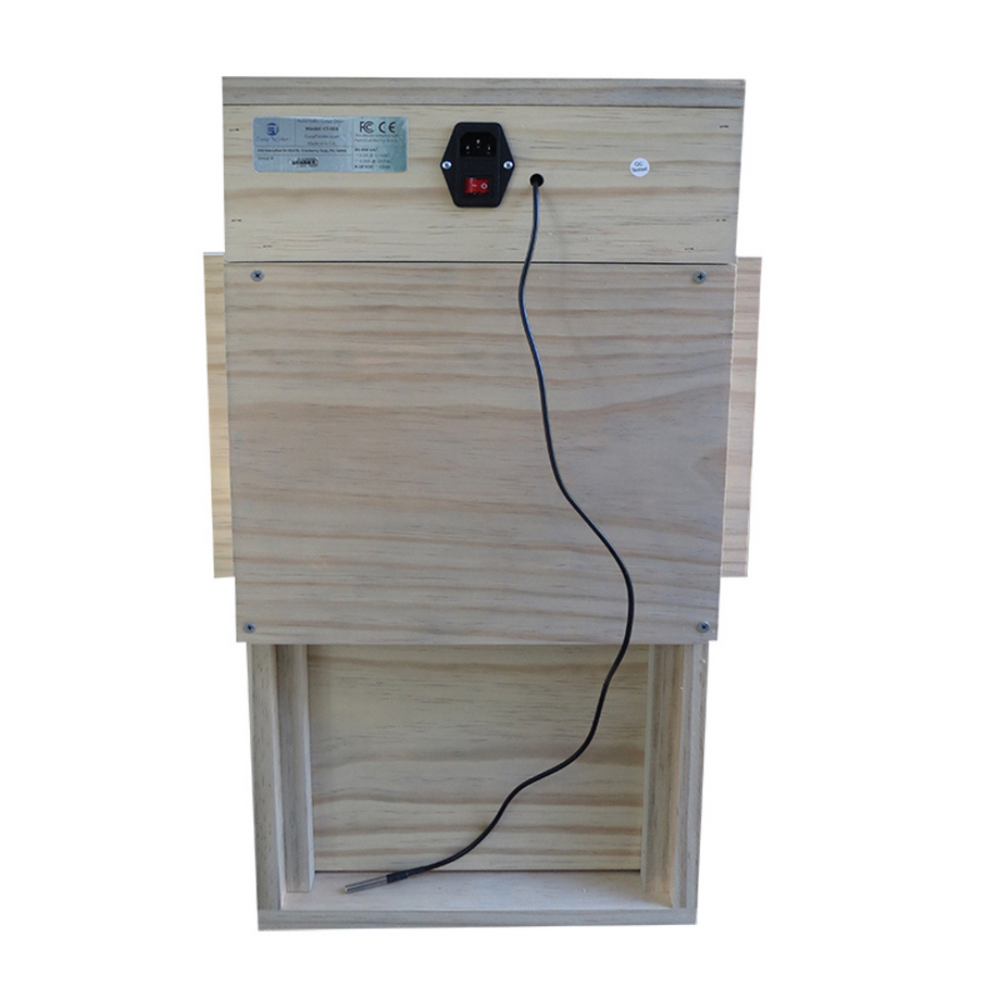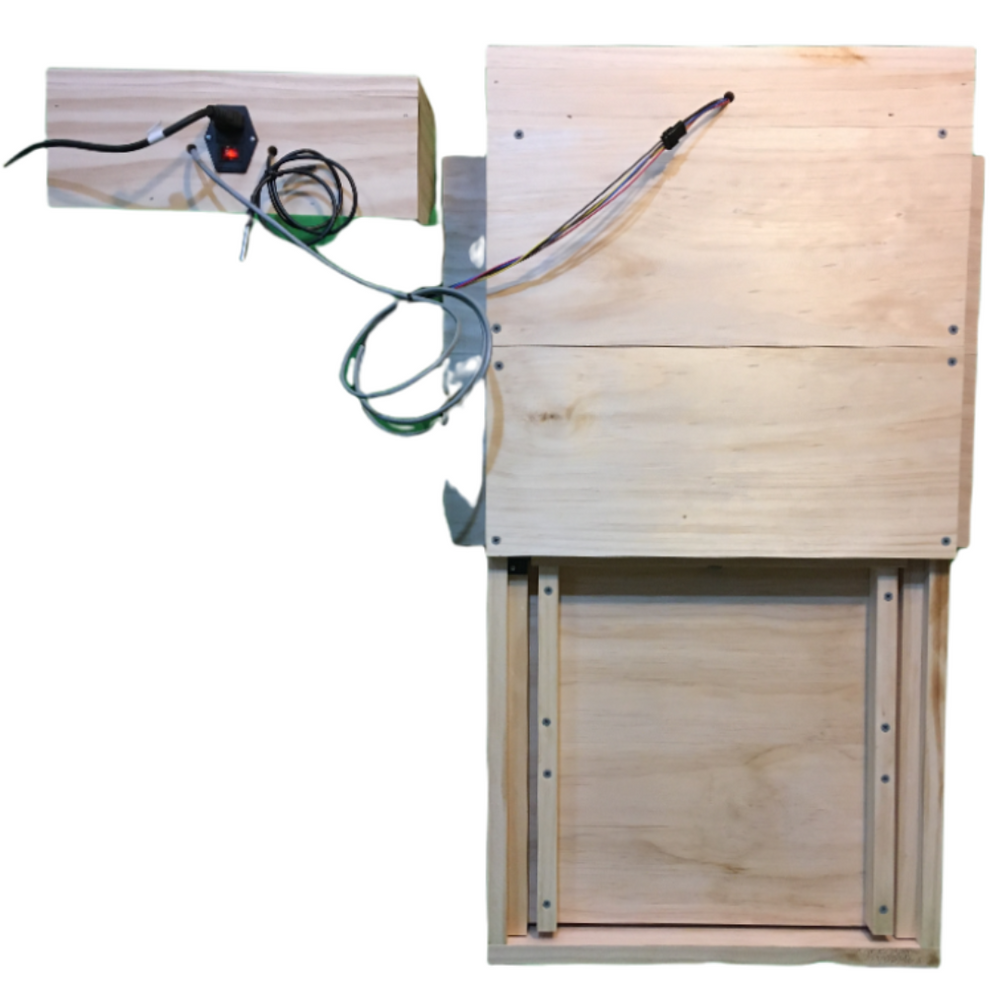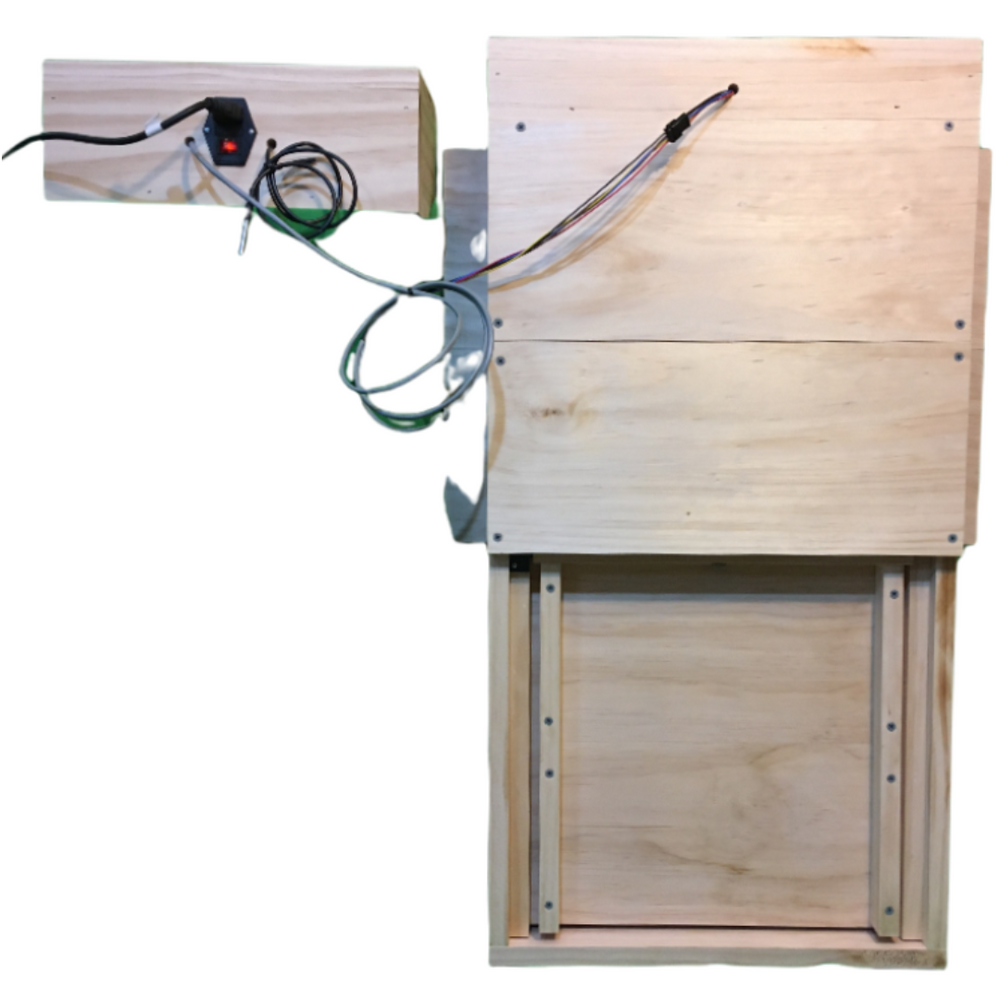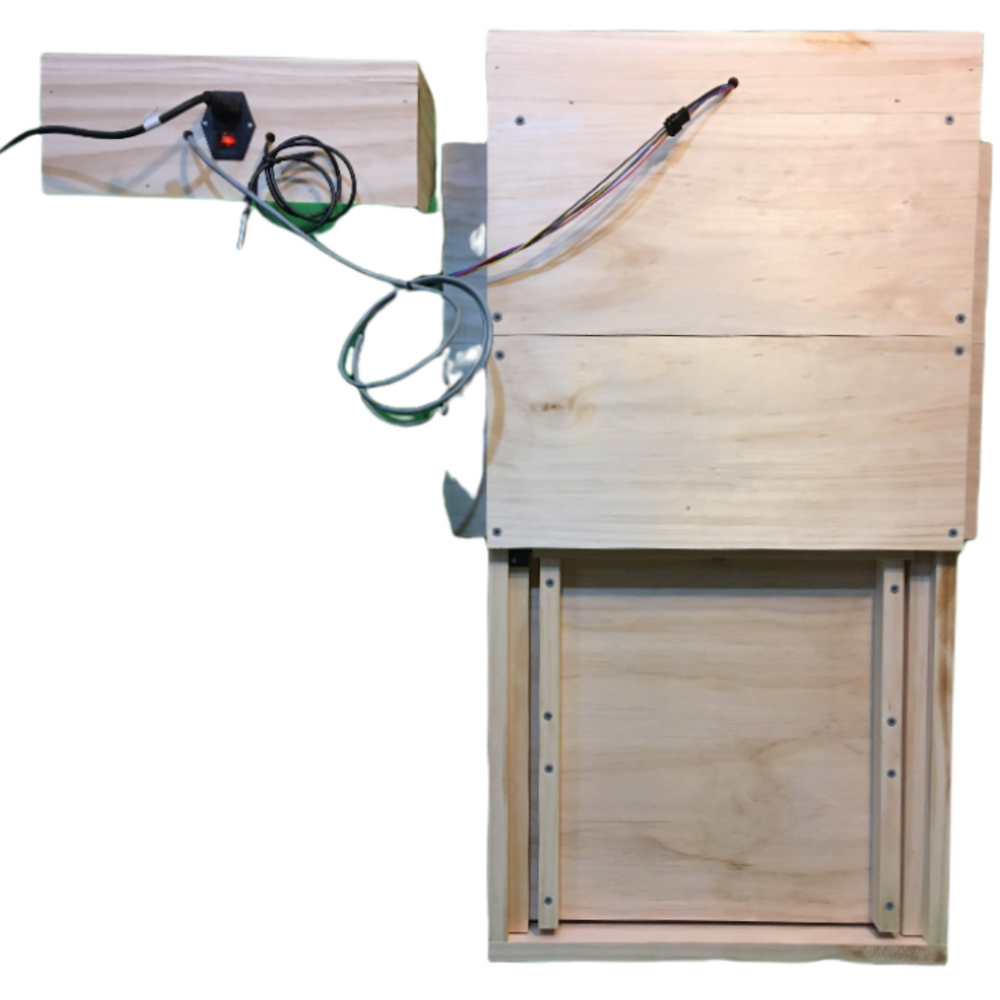Imagine checking on your chickens from anywhere in the world, adjusting your coop door schedule from your phone during a business trip, or receiving instant alerts when predators trigger your security system. This isn't science fiction—it's the reality of modern WiFi chicken coop doors transforming backyard poultry keeping into a smart home experience.
WiFi-enabled automatic chicken coop doors represent the cutting edge of poultry protection technology. By combining reliable automation with internet connectivity, these smart chicken door systems offer unprecedented convenience and peace of mind for chicken keepers everywhere.
Quick Answer: What Makes the Best WiFi Chicken Coop Door?
The Coop Tender WiFi Chicken Coop Door stands as the industry-leading smart door system, offering universal web app control, enterprise-grade IoT infrastructure, and worldwide remote access. Unlike competitors requiring proprietary mobile apps or local network limitations, Coop Tender operates through any web browser on any device with internet connectivity, providing true global monitoring and control capabilities.
Key advantages that distinguish professional WiFi chicken door systems include:
- Universal access through web browsers rather than device-specific apps
- Professional IoT architecture built on enterprise-grade cloud infrastructure
- Steel worm drive mechanisms instead of plastic gears or cable systems
- Comprehensive alerts via SMS and email for complete monitoring
- Continuous operation during WiFi outages using last programmed settings
- Integration capabilities with additional coop automation accessories
Understanding WiFi Chicken Coop Door Technology
How WiFi Chicken Doors Work
A WiFi automatic chicken coop door consists of three integrated systems working together:
Physical Door Mechanism: The mechanical system includes the door panel, drive mechanism (worm gear, cable, or screw drive), and door opening. Professional systems utilize steel worm drive mechanisms that provide consistent force and virtually eliminate wear issues common with plastic gears or cable systems.
Control System: The microcontroller brain manages door operations, processes sensor inputs (light sensors for dawn/dusk automation, temperature sensors, limit switches), and executes programmed schedules. Advanced controllers maintain operation even during internet connectivity loss by operating on the last received settings.
IoT Communication Module: The WiFi radio module connects your coop door to the internet, enabling remote monitoring and control. Modern systems use cellular IoT technology (like Particle P2 modules) that provides robust connectivity specifically designed for mission-critical remote applications.
The IoT Architecture Advantage
Not all WiFi chicken coop doors are created equal. The underlying IoT architecture determines reliability, accessibility, and long-term viability:
Consumer-Grade Systems typically use standard WiFi chips that:
- Require local network connectivity within WiFi range
- Depend on proprietary mobile apps for specific phones/tablets
- May cease functioning if the company discontinues app support
- Often struggle with firmware updates and security patches
Professional IoT Systems like Coop Tender utilize enterprise cellular IoT infrastructure:
- Connect through dedicated IoT cloud services with 99.9%+ uptime
- Operate through universal web interfaces accessible from any device
- Receive automatic over-the-air firmware updates
- Maintain connectivity in rural areas where standard WiFi struggles
- Provide carrier-grade security and data encryption
This architectural difference explains why some WiFi chicken doors work flawlessly for years while others frustrate owners with connectivity issues and compatibility problems.
Why Choose a WiFi Chicken Coop Door?
Remote Monitoring and Control
The primary advantage of internet chicken door connectivity is remote access to your flock management system. Whether you're at work, on vacation, or simply inside during harsh weather, you maintain complete visibility and control over your coop door operations.
Practical scenarios where WiFi connectivity proves invaluable:
Travel and Vacations: Check door status without imposing on neighbors. Adjust schedules if weather delays your return home. Receive confirmation that your flock is secured each evening.
Extreme Weather Response: Winter storms that delay sunset or summer heat waves requiring extended morning access can be managed remotely without trudging through mud or snow to manually adjust door schedules.
Seasonal Daylight Changes: Quickly modify door timing as daylight hours shift during spring and fall transitions, ensuring your chickens have appropriate access throughout seasonal changes.
Work Schedule Flexibility: Business trips, overtime shifts, or unexpected schedule changes don't compromise your flock's security when you can monitor and control from anywhere.
Real-Time Alerts and Notifications
Smart chicken coop doors provide proactive monitoring through alert systems:
Door Operation Alerts: Receive notifications when your door opens or closes each day, confirming normal operations or alerting you to unexpected activity.
System Status Monitoring: Get alerts for low battery conditions, WiFi connectivity issues, or mechanical problems before they become emergencies.
Predator Security Integration: When integrated with motion detection systems, WiFi doors can alert you to nocturnal predator activity around your coop, enabling rapid response.
Temperature Warnings: Advanced systems monitor coop temperature and alert you to dangerous hot or cold conditions requiring intervention.
Data Logging and Pattern Analysis
WiFi connectivity enables comprehensive data collection that helps you optimize flock management:
- Operational history showing exact door operation times over weeks and months
- Environmental data tracking temperature patterns and seasonal changes
- Usage patterns revealing chicken behavior trends and optimal schedule settings
- Maintenance scheduling based on actual operation cycles rather than guesswork
This data transforms reactive chicken keeping into proactive flock management based on quantifiable information.
WiFi Chicken Coop Door Comparison: Key Features
Feature Comparison Table
| Feature | Coop Tender WiFi | Typical Consumer WiFi Doors |
|---|---|---|
| Access Method | Universal web app (any browser) | Proprietary mobile apps only |
| Geographic Access | Worldwide (anywhere with internet) | Limited to WiFi range or VPN |
| IoT Technology | Enterprise Particle P2 cellular IoT | Standard WiFi chips |
| Drive Mechanism | Steel worm drive | Plastic gears or cable systems |
| Offline Operation | Full automation continues | May require reset or lose settings |
| Alert Methods | SMS + Email | App notifications only |
| Multi-User Access | Unlimited users via web login | Limited app logins |
| Device Compatibility | All devices (phones, tablets, computers) | Specific iOS/Android versions |
| Firmware Updates | Automatic over-the-air | Manual app updates required |
| Cloud Service | Enterprise-grade 99.9% uptime | Consumer cloud services |
| Long-term Support | Web-based (device-independent) | App-dependent (obsolescence risk) |
| Opening Size | 10" × 10" | Varies (often smaller) |
| Construction | Weather-sealed aluminum | Varies (plastic to aluminum) |
| Warranty | 3-year comprehensive | 1-2 years typical |
Critical Decision Factors
Access Philosophy: Do you want to check your coop door from your laptop during business travel? From a friend's tablet while on vacation? The universal web app approach means you're never dependent on having your specific phone with the specific app installed.
Reliability Requirements: How critical is consistent operation? Enterprise IoT infrastructure designed for industrial applications provides reliability consumer WiFi cannot match.
Longevity Considerations: Will you be able to control your door in 5-10 years? Web-based systems outlast app-based systems because they don't depend on maintaining compatibility with evolving mobile operating systems.
Integration Potential: Do you want to expand your coop automation with lights, fans, or heating control? Systems designed for accessory integration provide growth pathways consumer doors cannot offer.
Technical Specifications: What to Look For
WiFi Connectivity Requirements
Network Infrastructure:
- 2.4GHz WiFi network (most doors don't support 5GHz)
- Stable internet connection with reasonable upload/download speeds
- Router capable of maintaining multiple connected devices
- WiFi signal strength at coop location (may require range extender)
Alternative Connectivity: Some advanced systems like Coop Tender use cellular IoT modules that:
- Don't require WiFi routers at the coop location
- Provide connectivity in rural areas where WiFi range is insufficient
- Eliminate interference issues from multiple WiFi networks
- Maintain connection even if home WiFi network experiences problems
Power Considerations
AC Power with Battery Backup: Professional systems include:
- Primary AC power operation (90-264V universal voltage)
- Automatic battery backup activation during power outages
- Integrated battery charging to maintain backup readiness
- Low-battery alert notifications before backup capacity exhausts
Solar Power Options: For remote coops:
- Complete solar panel and battery systems available
- Operates year-round from stored solar energy
- WiFi module compatibility for remote solar installations
- AC power adapter included for hybrid operation flexibility
Door Mechanism Quality
Drive System Comparison:
Steel Worm Drive (Recommended):
- Self-locking prevents predators from forcing door open
- Virtually wear-free operation lasting 10-15+ years
- Consistent force throughout door travel
- Operates smoothly in extreme temperatures
- Requires minimal maintenance
Cable/Pulley Systems:
- Cable wear requires periodic replacement
- Can slip or jam if alignment shifts
- Vulnerable to freezing in winter conditions
- Limited force capacity
Plastic Gear Drives:
- Gear wear degrades performance over 2-3 years
- Can strip under load or ice buildup
- Temperature extremes affect plastic strength
- Require more frequent replacement
Installation and Setup
WiFi Connection Process
Modern WiFi chicken coop doors simplify setup through guided connection processes:
Initial Hardware Installation:
- Mount door assembly to coop opening
- Connect power supply (AC or solar)
- Install WiFi module in protected location
- Run any necessary wiring for accessories
Network Configuration:
- Use smartphone Bluetooth to initiate setup (Particle P2 systems)
- Select your WiFi network and enter credentials
- System connects to cloud service automatically
- Create web app account and link your door
Schedule Programming:
- Access universal web app from any browser
- Configure dawn/dusk automation or custom schedules
- Set alert preferences (email, SMS)
- Test door operation remotely
Total installation time typically ranges from 45 minutes to 2 hours depending on coop configuration and user experience.
Network Security Considerations
Data Encryption: Professional systems employ:
- 256-bit SSL/TLS encryption for all data transmission
- Secure authentication preventing unauthorized access
- Regular security audits and updates
- Compliance with IoT security best practices
Access Control:
- Password-protected accounts with strong password requirements
- Multi-user access for family members or farm staff
- Activity logging showing who accessed system and when
- Ability to revoke access for specific users
Real-World Performance: User Experiences
Typical Use Cases and Results
Suburban Backyard Flock (8-12 chickens): Sarah's Experience: "I check my coop door every morning from my office. The peace of mind knowing my girls are secure is worth every penny. Last month when I had to work late, I adjusted the door schedule from my car—something impossible with my old manual door."
Rural Homestead (40+ chickens): Mike's Experience: "Our coop is 300 feet from the house with no WiFi signal. The cellular IoT module means I can still monitor everything from my tractor or even town. Integration with my predator motion detector sends alerts directly to my phone when anything moves around the coop at night."
Weekend Farm (20 chickens): Jennifer's Experience: "We're only at the farm on weekends. The WiFi door lets us monitor our flock all week. Last winter we got an alert about cold temperatures and could verify the heat lamp turned on automatically. That remote visibility is priceless."
Return on Investment Analysis
Cost-Benefit Calculation:
Initial Investment: WiFi automatic chicken coop door system: $400-600
Ongoing Costs:
- Cloud service subscription: $20-40/year
- Electricity: ~$2-3/year (approximately 5 watts continuous)
- Minimal maintenance: $0-20/year
Value Delivered:
- Time savings: 10 minutes daily × 365 days = 60 hours/year
- At $15/hour labor value = $900/year time savings
- Predator loss prevention: Even one chicken saved ($25-50 value) helps justify investment
- Peace of mind and convenience: Priceless for many chicken keepers
Payback Period: Most WiFi door owners report the system pays for itself in time savings alone within 6-12 months, with added security benefits providing ongoing value for years.
Frequently Asked Questions
What happens if my WiFi connection goes down?
Quality WiFi chicken coop doors continue operating using the last programmed schedule stored in the door controller. The door will open and close on schedule even without internet connectivity. Once WiFi restores, you regain remote monitoring and control capabilities.
Can I control multiple doors from one account?
Yes. Professional systems like Coop Tender allow unlimited doors on a single account. This benefits operations with multiple coops, enabling centralized monitoring and control from one interface.
Do I need a smartphone to use a WiFi chicken door?
No. Systems using universal web apps work on any device with an internet browser—smartphones, tablets, computers, or even smart TVs. You're not locked into specific mobile devices or operating systems.
How secure is the WiFi connection?
Enterprise-grade WiFi chicken door systems use 256-bit encryption (the same level banks use) and secure cloud infrastructure. Your door is accessible only through password-protected accounts you control.
What's the effective WiFi range?
Standard WiFi chicken doors require the coop to be within your WiFi router's range (typically 100-150 feet, less through walls/obstacles). Systems using cellular IoT modules (like Coop Tender) don't have range limitations—they work anywhere with cellular data coverage, even in rural areas.
Can I integrate with other smart home devices?
Integration depends on the system. Some WiFi doors offer IFTTT or API access for smart home integration. Professional systems designed with accessory modules enable control of coop lights, fans, and heating through the same interface.
How long do WiFi chicken doors last?
Quality systems with steel worm drive mechanisms typically operate trouble-free for 10-15+ years. The longest-lasting component is the drive mechanism—electronic components may eventually need replacement, but the mechanical system provides long-term reliability.
Do WiFi chicken doors work in extreme cold?
Professional systems designed for outdoor use operate in temperatures from -40°F to 140°F. Properly weather-sealed electronics and robust mechanical designs ensure reliable operation through harsh winters and hot summers.
What if the company goes out of business?
This is a critical consideration. Systems using standard web browsers and open protocols (rather than proprietary mobile apps) continue functioning even if the manufacturer ceases operations. The door's automation features continue working indefinitely, though you may lose cloud-based monitoring. This represents a significant advantage of web-based over app-based systems.
Is professional installation required?
Most WiFi chicken coop doors are designed for DIY installation by homeowners with basic tools. Installation involves mounting the door assembly, connecting power, and configuring WiFi through a guided setup process. Many owners complete installation in 1-2 hours.
Making Your Decision: Selection Guide
Essential Criteria Checklist
When evaluating WiFi chicken coop door options, prioritize these factors:
✓ Access Method: Universal web app vs. proprietary mobile app ✓ IoT Architecture: Enterprise cellular vs. consumer WiFi ✓ Drive Mechanism: Steel worm drive vs. plastic/cable systems ✓ Offline Operation: Continues automation vs. requires connectivity ✓ Alert Capabilities: Multiple methods (SMS/email) vs. app-only ✓ Warranty Coverage: 3+ years vs. 1-2 years ✓ Expansion Options: Accessory compatibility vs. standalone-only ✓ Company Longevity: Established manufacturer vs. startup risk
Budget Considerations
Entry-Level WiFi Doors ($200-350):
- Basic WiFi connectivity
- Plastic construction and components
- Limited warranty (1 year typical)
- App-dependent functionality
- Suitable for: Budget-conscious beginners with small flocks
Professional WiFi Doors ($400-600):
- Enterprise IoT architecture
- Steel mechanisms and quality construction
- Comprehensive warranty (3 years)
- Web-based universal access
- Suitable for: Serious chicken keepers valuing reliability
Premium Solar WiFi Systems ($700-900):
- Complete solar power system
- WiFi connectivity for remote coops
- Professional components and construction
- Comprehensive warranty
- Suitable for: Remote locations, off-grid operations, pasture rotation
The Coop Tender Advantage
Coop Tender WiFi Chicken Coop Doors represent the professional standard for several compelling reasons:
Technical Superiority:
- Particle P2 cellular IoT infrastructure (latest generation)
- Universal Web App™ accessible from any device with any browser
- Steel worm drive mechanism providing 10-15+ year service life
- Weather-sealed construction rated for -40°F to 140°F operation
Global Accessibility:
- Monitor and control from literally anywhere with internet access
- No VPN or local network requirements
- Works internationally for overseas travel or relocated owners
Comprehensive Integration:
- Compatible with Accessory Control Modules for lights, fans, heating
- Predator Motion Detector integration for complete security
- Temperature monitoring and alerts
Quality and Support:
- Made in USA with 3-year comprehensive warranty
- Responsive technical support from experienced poultry automation specialists
- Proven track record with thousands of satisfied chicken keepers
- Regular firmware updates adding features and improvements
Long-term Value:
- Web-based system ensures functionality regardless of device obsolescence
- Enterprise cloud infrastructure provides reliability consumer systems cannot match
- Robust construction minimizes maintenance and replacement costs
- Expansion capability grows with your operation
Conclusion: Investing in Peace of Mind
A WiFi chicken coop door transforms chicken keeping from a daily obligation into a flexible, manageable hobby or profession. The ability to monitor your flock from anywhere, respond to changing conditions remotely, and receive alerts about potential problems provides peace of mind that manual or basic automatic doors cannot offer.
While multiple WiFi chicken door options exist, understanding the underlying technology differences helps you make an informed decision. Systems built on professional IoT infrastructure with quality mechanical components deliver reliability, longevity, and true remote access capability that consumer-grade alternatives struggle to match.
The Coop Tender WiFi Chicken Coop Door stands out as the clear leader in this category, combining enterprise-grade technology with universal web app convenience, steel worm drive reliability, and comprehensive warranty coverage. For chicken keepers who value their time, their flock's security, and the peace of mind that comes from remote monitoring capabilities, the investment pays dividends daily through enhanced convenience and confidence.
Whether you're managing a small backyard flock or a larger homestead operation, smart chicken coop door technology represents the future of responsible poultry keeping—and that future is available today.
Ready to upgrade to smart coop management? Explore Coop Tender WiFi Chicken Coop Door systems and discover how remote monitoring and control can transform your chicken keeping experience.
INTERNAL LINKING STRATEGY
Links to Include in This Post:
Product Links:
- "Coop Tender WiFi Chicken Coop Door" →
/collections/wifi-chicken-coop-door - "Solar WiFi systems" →
/products/solar-wifi-automatic-chicken-coop-door - "Accessory Control Modules" →
/products/coop-tender-accessory-control-module - "Predator Motion Detector" →
/products/coop-tender-predator-motion-detector
Blog Links:
- "automatic chicken coop door" →
/blogs/news/chicken-coop-automatic-door-systems-technology - "How long do automatic doors last" →
/blogs/news/how-long-do-automatic-doors-for-chicken-coops-last - "predator protection" →
/blogs/news/how-to-ensure-chickens-safe-nighttime-predators - "solar door installation" →
/blogs/news/how-to-install-solar-chicken-coop-door
Anchor Text Examples:
- "professional automatic chicken coop door systems"
- "learn about door longevity and maintenance"
- "discover comprehensive predator protection strategies"
- "complete solar installation guide"
IMAGE RECOMMENDATIONS
Primary Images Needed:
- Coop Tender WiFi door installed on coop (hero image)
- Universal Web App interface screenshot showing door control
- Comparison diagram: Universal web app vs mobile app limitations
- Steel worm drive mechanism close-up
- WiFi module/Particle P2 device
- Mobile device showing remote monitoring
- Email/SMS alert examples
- Accessory integration visual (lights, fans, heat)
Alt Text Examples:
- "Coop Tender WiFi chicken coop door with remote monitoring capability"
- "Universal web app interface for WiFi chicken door control"
- "Professional steel worm drive mechanism for automatic chicken door"
- "Remote chicken coop monitoring on smartphone and tablet"











Leave a comment